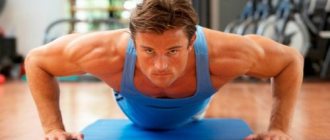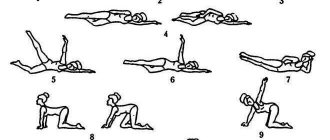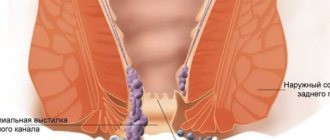The treatment of hemorrhoids - chronic inflammation of the venous cavities of the rectum - in addition to medications, necessarily includes physical exercise, diet, and requirements for changing the usual diet. Yoga for hemorrhoids is not just gymnastic movements, this direction allows men and women to change their attitude towards life, and at the same time solve many troubling problems.
Hindus explain the effect on health by restoring the functioning and cleaning of the main energy centers (chakras). According to classical teaching, the 7th chakra (Muladhara) and a person’s greed for clothes, money, and other property are to blame for hemorrhoids. To get rid of an exacerbation, yogis recommend throwing away old things and giving someone a gift.
In the modern world, many fans of classes have appeared. They are available to everyone and are practiced in fitness clubs. Sometimes we don’t even realize during training that we are performing targeted exercises from the yoga complex (callanetics, Pilates, stretching).
Benefits of yoga
When treating any disease, you must first eliminate the causes of its occurrence, otherwise the disease will constantly return. Even the most advanced yoga classes will not save you from hemorrhoids if, along with performing asanas, you do not resort to a certain set of measures, which include following a proper diet and revising your lifestyle.
Correct execution of all movements and exercises affects the processes in our body, causing the disease to lose ground:
- the functioning of the abdominal and pelvic region is normalized, intestinal function is brought back to normal;
- all the muscles of the body begin to work and become stronger;
- blood flow to all areas improves, including in the anal sphincter area;
- food is digested better, stools are normalized and softened;
- various congestion in the pelvic area is eliminated.
Yoga is not a method of treating hemorrhoids, but like a different level of life. Beginners should strive to perform the exercises as accurately as possible, gradually moving from simple to complex asanas. Persistent training will give amazing results over time.
Yoga classes: prevention and treatment of hemorrhoids
Yoga exercises are called asanas. Their implementation must be carried out according to the rules; mastering the method is not difficult. You need to practice regularly, it is better to start with an experienced instructor. Special asanas involve activating the work of all abdominal organs, proper breathing, and blood circulation. One of the reasons for the formation and inflammation of hemorrhoids is impaired intestinal activity, constipation.
The result of mastering the technique is soft, regular stool, natural peristalsis without laxatives. All muscle groups, including the rectal sphincter, take part in the poses. Its training is useful for people of “sedentary” professions, who spend a long time on their feet. Exercises eliminate blood stagnation in the lower parts of the body, including in the venous system of the rectum. At the same time, the outflow of blood is accelerated while ensuring a sufficient influx of oxygen-enriched red blood cells.
Some movements can be performed discreetly anywhere. For overweight people, asanas help get rid of increased appetite and increase muscle mass. The treatment complex is suitable for both beginners without physical training and people who have previously been involved in sports. The instructor will tell you which exercises are best to start doing yoga therapy with.
Self-mastery is less desirable, since it is important to achieve the correct load on the muscles and eliminate contraindicated exercises. Not all doctors are able to advise the patient on this issue. Weakened people make a mistake when they try to speed up recovery by immediately performing complex asanas for hemorrhoids. Instead of a good result, they get an increase in pressure in the peritoneal cavity, increased inflow and stagnation of blood in the nodes, another acute process.
Exercises should not cause fatigue, pain, discomfort, or negative emotions. These problems can be solved by choosing the correct load.
What determines the effectiveness of yoga for illness?
If we compare asanas with regular morning exercises, the distinctive features are:
- predominantly static poses (motionless);
- increased attention to breathing and water regime;
- targeted effect on the intestines to ensure the removal of toxins;
- influence on the general condition, relieving nervous stress and stress.
You don’t need any special equipment to perform it; once you learn the technique, you can practice at home at any time.
Local impact on hemorrhoids causes:
- proper contraction of the muscle fibers of the external sphincter of the anal canal, preventing strangulation of nodular formations;
- connection to the work of the pelvic and perineal muscles;
- eliminating blood stagnation and the risk of thrombosis;
- restoration of sufficient blood circulation in the pelvic organs and intestines.
General actions include:
- training and uniform strengthening of all muscles of the body without “pumping up”;
- acceleration of metabolic processes, production of additional energy in tissues;
- synthesis of endorphins (good mood hormones).
The results of the training are:
- improving the absorption of essential substances from food;
- detoxification of the body by removing toxins and waste contained in fecal debris;
- activation of the functioning of all internal organs;
- stimulation of the immune system, increased production of beneficial bacterial flora.
Asanas for beginners
Those beginners who cannot boast of good physical shape should focus on exercises that do not put strong tension in the abdominal area and do not lead to increased blood supply to the muscles.
A similar effect for hemorrhoids can do more harm than good. But even when performing light exercises, if you feel the slightest discomfort, you need to slowly return to the previous position. It is important that yoga practice is enjoyable, so start practicing only in a positive mood.
Tadasana
“Mountain pose” is considered basic, and it is recommended to master yoga from it:
- The legs are straightened, the feet are placed shoulder-width apart, the kneecaps are tensed, moving slightly upward.
- The pelvic muscles are compressed, the stomach is pulled in, the neck is straight all the time, the face is relaxed.
- The back, along with the back of the thighs, is tightened.
- We take a breath and seem to lift the top of our head up, reaching for it with our whole body, as if we want to reach the ceiling with it.
- With our legs, on the contrary, we seem to be trying to pull ourselves down to the floor.
- We strain all the muscles except the neck and face.
Hold your breath, feel how all the vertebrae move. Next, you begin to exhale, lowering your head and returning to your original state. It is recommended to drink a glass of clean water before exercise. The liquid will flush the intestines, and in the future will serve as an effective preventative against stagnation and constipation in the intestines.
Samasthiti
“Praying Pose” - execution follows the same principle as the “Mountain Pose” asana, but at the same time:
- Both arms (straightened on both sides) also rise and extend upward.
- The body stretches after the arms, the legs are still down.
- The stand is the same.
Arha Chadrasana
"Bending Tree" Having returned to the base position, we begin to slowly tilt the body to the right side, straighten up, then to the left side. We repeat the movement 10–12 times. In this case, the upper part of the body remains straight, does not fall forward or backward, and the body from the waist down is motionless, only the upper part moves. This exercise normalizes the movement of food along the entire intestine.
Adho Mukha Svanasana
"Downward facing dog." Smoothly kneel down, then just as smoothly place your buttocks on your heels.
Now follow these steps:
- Lean forward and touch your head to the floor.
- Extend your arms and place them on the floor in front of you.
- Calm your breathing.
- Smoothly begin to straighten your knees, without lifting your hands from the floor, gradually pushing your buttocks up.
The exercise is done smoothly, as a result, only your palms should remain on the floor, you stand completely on your entire foot. During the execution, the muscles of the back of the body are well stretched.
The most primitive but effective complex
Many proctologists recommend performing these exercises, not suspecting that yoga offers this method to remove hemorrhoids.
Proctologist Kolesova: Hemorrhoids are a serious disease that causes a lot of anxiety, fortunately, there are remedies that help both relieve symptoms and help heal. One of them …
More details>>
- Mula Bandha. This exercise does not require any preliminary preparation; it can be performed while in a work chair, in transport, or in urban conditions. People around you won't notice anything. It is necessary to tense the pelvic muscles in the anus area. The time and amount of exercise does not matter.
- The second exercise can be done during your lunch break or just at home. This is leg swings. They can be performed with straight legs alternately, or you can also lift the leg bent at the knee to the stomach alternately.
Despite the fact that this complex is the simplest, it is quite effective against hemorrhoids. The same practice can be used for people who sit most of the day.
The first exercise can be performed while sitting, the second - in the form of an industrial warm-up. But there is also a more complex complex, which already requires a special approach and a certain meta.
Ashwa Sanchalanasana
"Rider's Pose." You stand up, then lower your arms down, placing your palms on the floor on either side of your left foot. Then:
- Lift your right leg and stretch it back, parallel to the floor. Both legs are positioned at an angle of 90°, the left one may bend slightly. The arms remain straight.
- Bend your back, trying to squeeze your shoulder blades together, and gradually throw your head back.
Try to stand in this position for as long as possible, inhaling and exhaling evenly. When tired, bring your right leg back, move your palms to either side of your right foot, and repeat the exercise with your left leg extended.
If you feel good, try, standing on one leg, lifting your palms off the floor, spreading them to the sides or resting them against the wall opposite.
Poses for advanced
This set of exercises is designed for people who are in good physical shape, professionals or amateur athletes. The asanas in this complex look different and are more difficult to perform. But if you strictly follow all the instructions, there will be no problems with implementation.
Let us remind you that the main requirement is smoothness and unhurriedness. Follow the instructions carefully and get the desired result.
Adho Mukha Svanasana with leg raises
Get into a downward-facing dog position (buttocks up, just your palms and feet on the floor). Then:
- Smoothly lift your left leg without turning your torso.
- Bring your leg to the point where it is in line with your back (you can stop at a lower point that is accessible to you).
- Hold your leg in this position, then slowly lower it and repeat the asana for your right leg.
Utkatasana on toes
"Chair Pose" on tiptoes. Stand straight, feet slightly wider than shoulder-width apart, arms extended in front of you. Next you need:
- Rise up on tiptoes.
- Sit down as low as possible (it is advisable for the buttocks to take a position parallel to the floor).
Make sure your back remains straight. Stay like this, then smoothly straighten up.
Dhanurasana
"Bow Pose." Lie on the mat on your stomach, legs slightly apart. Then:
- At the same time, lift your legs, arms and head off the floor.
- Your head goes up, you try to grab your ankles with your hands.
As a result, your arms should resemble a bow string, and your body and legs should resemble the shaft. The task is to apply effort and smoothly pull the “string”.
You need to breathe evenly in this position, maintaining balance.
Exercises for beginners: yoga that treats hemorrhoids
Asanas against hemorrhoids:
- Mountain Pose (or Tadasana). This is the starting pose for yoga. Stand straight, spread your lower limbs slightly, strain your knees so that their cups stretch up and then forward. At the same time as these actions, stretch the spinal column, pull the rear thigh muscles. Keep your neck straight, relax your facial muscles. Raise your arms straight above you, rising on your toes, imagine that you are being pulled up. Stretch your entire body, try to stretch your spine from crown to toes. Return to the original position. When rising on your toes, inhale, at the top of the stretch, hold your breath, lower on your heels and exhale. This asana perfectly trains the abdominal muscles and also has a positive effect on the intestines.
- Rotation (or Kati-Chakrasana). Stand straight, hands shoulder-width apart. Begin: pull your right hand forward, bend your left so that the index and thumb touch the forearm area. Slowly turn your body, while moving your outstretched arm back. The lower part of the body should remain motionless. At the end of the rotation around the waist, return to the starting position. Immediately start turning in the other direction. Breathing is free. The exercise is duplicated 12 times.
- Bent tree (or Tiryaka-Tadasana). Get into Tadasana. Breathing is free, back straight, chin slightly up. Take turns bending in both directions. Make sure your pelvis and shoulders are in the same line. Perform 12 bends in each direction. The lower part of the body should be motionless during the exercise, the pelvis should not deviate to the side.
- Massaging the abdomen (or Udara-karshanasana). Squat down with your hands on your knees. Turn your torso to the right, while tilting your left knee down. The other knee is vertical. Return to the starting position and do the same actions in the opposite direction, tilt your right knee towards the floor. While turning, try to look behind you. The spine is straight, breathing is free. In each direction - 12 twists. This is the most beneficial pose for the abdominal organs.
- Root Lock (or Mula Bandha). Everything is simple, but everything is effective - consciously squeeze and unclench the muscles of the anus. Using muscle force, you need to pull the anus straight into the rectum. At first, the exercise is difficult, and only a few manage to do it 10 times in a row. Ideally, you need to perform it for 2-3 minutes. But exercise helps the venous outflow of blood, and this improves blood circulation in the rectum.
To begin with, stick to this small group of exercises. Try doing them daily for 7-10 days. When everything works out well, efficiently, and with ease, add new exercises to the treatment cycle.
Yoga for hemorrhoids will also help those who are already familiar with this movement. Simple asanas can be performed to warm up. But if your body is already ready for more difficult things, move on to them. Of these poses, there are two that are most effective for hemorrhoids.
Yoga - exercises for hemorrhoids for those who are physically fit:
- Bow Pose (or Dhanurasana). Starting position – lying on your stomach face down. Spread your knees hip-width apart. Slowly lift your upper body and legs, moving your arms back, trying to grab your ankles with them. Raise your head up slowly, smoothly, hold your breath, it should be free. Grab your feet and stay in this position for several minutes without losing your balance.
- Virabhadrasana. Keep your back straight, put your left leg to the side, squat on it, leaving your right leg straight. Touch the floor with your left hand and begin to stand up from this position. Straighten your left arm and leg while lifting your right leg. And move your right hand to the side so that there is an angle of 180 degrees between your hands. Repeat the same, standing on the other leg.
Remember that if there is pain or severe discomfort, you cannot continue exercising. During periods of exacerbation, yoga exercises can be postponed for a calmer time.
Prohibited tricks
Considering the causes of hemorrhoids, when practicing yoga, you should strictly avoid exercises that can increase tension in the abdominal area and cause dilation of blood vessels in the affected areas. Any poses related to squats, strength exercises and heavy lifting (dumbbells, etc.) are prohibited.
For the same reason, it is not recommended to ride a bicycle or go horseback riding. Aerobics is not prohibited, but tension in the abdominal area should be avoided, as mentioned earlier.
In yoga, there are the famous “Lotus Pose” and “Sukhasana” (“Comfortable Pose”), which are contraindicated for hemorrhoids.
Even if you perform the prescribed exercises, but one day you feel a deterioration in your health (hemorrhoids worsen), it is strongly recommended to interrupt your exercises for several days and avoid any physical activity. Instead, you should try breathing exercises.
Whatever gentle yoga routine you choose, be sure to consult your doctor, who will assess your condition and assess the safety of future classes. And only after receiving the “okay”, proceed.
In what cases is yoga contraindicated for hemorrhoids?
In the initial stages of the disease and in the absence of exacerbations, yoga classes are very useful. But if it progresses, is advanced and has a third or fourth stage, yoga is contraindicated. In this case, treatment is carried out more radically: either using infrared therapy or surgery.
By ignoring this fact, you will cause harm to the body, which can manifest itself in the following complications:
- exacerbation of paraproctitis;
- involuntary excretion of feces;
- thrombosis of hemorrhoidal formations;
- introduction of infection into the blood;
- the appearance of pus and abscesses;
- anemia.
You should not self-medicate if you do not know exactly what stage of development hemorrhoids have. Consult a doctor, and only with his permission begin classes.
Yoga is a great way to heal your body and start metabolic processes with renewed vigor, especially if you have such a delicate disease as hemorrhoids. The result of regular training and your efforts will be not only toned body muscles, but also the disappearance of pain and inflammation in the problem area.











